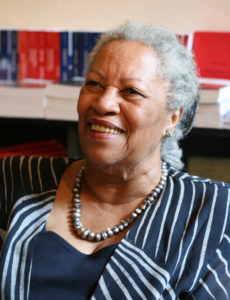The “Group Nature” of Toni Morrison’s Novels

“My writing expects, demands, participatory reading . . . It’s not just about telling the story; it’s about involving the reader.”
—Interview w/ Claudia Tate
This piece on the “group nature” of Morrison’s work aims to provide several helpful contexts for readers:
1. How does Toni Morrison conceive of her reader’s involvement in her work, and why is this so important to her?
2.. What are some tips that apply particularly to reading a Toni Morrison novel?
Toni Morrison’s Ideas about Readers
In many of her essays and interviews, Morrison articulates one of her key objectives in creating her art, which is getting the reader to participate in making the story. While this involves readerly empathizing, anticipating, questioning, and reacting, it also requires something more evanescent.
Crucial to the readerly encounter with Morrison’s literary world is mystery. Things that are secret, unknown, or remains unexplained are mysteries, according to a dictionary definition, and there are many unknowns for readers to encounter. We must be willing to puzzle some out ourselves, accept a lack of firm resolutions, and give up on missing pieces, knowing that the blank, the resistance, or the gap is there for a reason. Perhaps you have read a novel by, say, Virginia Woolf (English), Haruki Murakami (Japanese), Ishmael Reed (American), or some other writer’s novel from approximately the last 120 years about which you could say, “this book leaves a lot unsaid or unconnected, and the author means it to be this way,” then you have encountered what’s become known as “modernist” fictional technique. Space is left in between parts, the parts don’t line up easily: readers must enter into the mystery of what this is about.

at L’arbre a Lettres bookstore, Paris, 2009 by Olga Besnard /shutterstock
More specifically, Morrison’s fictional practices are aligned with principles of African-American art: the unknown or mysterious is considered a natural and vital aspect of the whole; more like a contrary dinner guest than a contradictory interloper. And one is expected to interact with it. A fuller discussion of the cultural history and artistic principles of a Black Aesthetic as they pertain to Morrison’s work can be found in another blog on my site: African American Aesthetics. Here, I want specifically to consider how readerly participation in the Morrisonian text is conceived in “ways that are indisputably black”:
“If my work is faithfully to reflect the aesthetic tradition of Afro-American culture, it must make conscious use of the characteristics of its art forms and translate them into print: antiphony, the group nature of art, its functionality, its improvisational nature, its relationship to audience performance, the critical voice which upholds tradition and communal values and which also provides occasion for an individual to transcend and/or defy group restrictions.
— “Memory, Creation, and Writing”
Antiphony in this context is what is termed the call-response African-based aesthetic. Just as in the song-form of captured and enslaved Africans, “in which a singer or instrumentalist makes a musical statement which is answered by another1,” so the readers of Morrison’s novels are envisioned as responding in some way to her Call.
Oh, Mary, Oh Martha, Ring Them Bells
And even though a novel cannot be performative and improvisational as can a jazz band playing for an appreciative and responsive audience, it can strongly suggest such features, as my blogpost on Intermediality passionately argues.2 Morrison furthermore wants her readers to encounter those who “defy” restrictions and conventions in order to possibly alter their perceptions of themselves as well as others. Nowhere are all of these characteristics more explicit than in the mysterious, nameless narrator of Jazz, the middle volume of the Beloved trilogy, as when the narrator says this when she is wondering about Violet Trace’s motivations: “Good luck and let me know” (5).
“Caviar and Grits”
 This phrase was coined by mid-20th century jazz critic Leonard Feather to describe Billie Holiday’s unique voice, its dual tonality of elegance and rawness. It also aptly describes the paradoxical tonality of Jazz’ nameless narrator as well. “Sth. I know that woman,” begins her story, with the gossipy, all-knowing vocalizing that impacts readers aurally throughout the novel. But her (or its, as some readers argue) authority disintegrates dramatically near the end. In telling the story-sequence of Golden Gray’s trip from Baltimore to rural Virginia in order to meet his father, the narrator breaks out of the story-frame in order to chastise herself.
This phrase was coined by mid-20th century jazz critic Leonard Feather to describe Billie Holiday’s unique voice, its dual tonality of elegance and rawness. It also aptly describes the paradoxical tonality of Jazz’ nameless narrator as well. “Sth. I know that woman,” begins her story, with the gossipy, all-knowing vocalizing that impacts readers aurally throughout the novel. But her (or its, as some readers argue) authority disintegrates dramatically near the end. In telling the story-sequence of Golden Gray’s trip from Baltimore to rural Virginia in order to meet his father, the narrator breaks out of the story-frame in order to chastise herself.
Necessary story-context: “Golden Gray” is the actual name given to the young, blonde man who finds out from his mother—living with him and their servant, Truebelle, in Baltimore since he was born—that his father is Black. Gray goes on horseback to the countryside where his mother’s family plantation was, and where is father still lives, hell-bent on confronting him. (If you’ve ever read William Faulkner’s novel Absalom, Absalom, swirling with “miscegenation” themes surrounding its character named Charles Bon, you will see some parallels with Morrison’s G.G.) Furthermore, along the way he discovers a naked, berry-black woman in the woods whom folks called “Wild” and takes her to his father’s cabin to confound the confrontation. This pregnant “Wild” woman, who bears further discussion in another blogpost, seems to alter the narrator’s poor opinion of Golden Gray: “What was I thinking of? How could I have imagined him so poorly?” (160).

Cream-colored suit /Pinterest
So Jazz’ narrator changes her mind, staging herself into the story-world with him in a kind of imaginary revision of things:
I have to be a shadow who wishes him well, like the smiles of the dead left over from their lives. I want to dream a nice dream for him, and another of him. Lie down next to him, a wrinkle in the sheet, and contemplate his pain and by doing so ease it, diminish it. I want to be the language that wishes him well, speaks his name, wakes him when his eyes need to be open (161).
Golden Gray is rather “woke,” to use a contemporary idiom, when he goes off into the woods with Wild, never to be seen again! However, the narrator only sees herself in this eerie, rural-Virginia chronotope: she “want[s] to be the language that wishes him well” concerning Golden Gray, which intentionally reveals that she is not so sure she can control her language.
Repositioning herself as one of the story’s characters, the narrator identifies herself as vulnerable. Readers have assumed she was in control, and now she is not. The narrator is fickle, though, and later in the novel asserts her authority over her storytelling: “well, it’s my storm, isn’t it? I break lives to prove I can mend them back again” (219) and this vacillation serves to draw readers into trying to make something out, participating in the narrative unfolding.
Responses Interlude: reflect, write, post
How might a vacillating, unreliable narrator be appropriate for a book entitled Jazz, set in the 1920’s in Harlem, New York?
Here’s a discussion point you might use (but don’t have to) to get you started:
Difficult to pin down, but also rather down-to-earth, Morrison’s narrator is surprisingly frank in addressing the reader concerning her generative prowess as an author who can “break” and “mend” people but who also shares in their pain (219). And she is also frank about her own limitations, as in her remorseful confession:
“Busy, they were, busy being original, complicated, changeable–human, I guess you’d say, while I was the predictable one, confused in my solitude into arrogance, thinking my space, my view was the only one that was or that mattered. I got so aroused while meddling, while finger-shaping, I overreached and missed the obvious” (220).
Jazz’s narrator is “signifying,”3 in the African-American critical sense of that term; on he/r own narrative performance, casting it in ironic relation to the reader’s conventional assumptions about the circulation of power between author, text, and reader. Narrative authority no longer flows in predictable channels.
So, back to the question:
How might a vacillating, unreliable narrator be appropriate for a book entitled Jazz, set in the 1920’s in Harlem, New York?
Next: The Reader Supplies the Emotions.
And don’t forget to sign up for the Newsletter at the bottom of any page!
